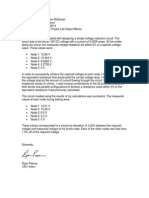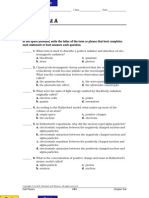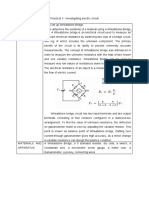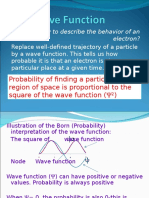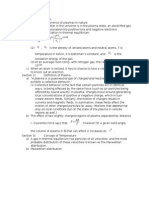EEN2056 Tutorial 2
EEN2056 Tutorial 2
Uploaded by
Paramesvaran VeerasingamCopyright:
Available Formats
EEN2056 Tutorial 2
EEN2056 Tutorial 2
Uploaded by
Paramesvaran VeerasingamOriginal Description:
Copyright
Available Formats
Share this document
Did you find this document useful?
Is this content inappropriate?
Copyright:
Available Formats
EEN2056 Tutorial 2
EEN2056 Tutorial 2
Uploaded by
Paramesvaran VeerasingamCopyright:
Available Formats
EEN2056 Physical Electronics
Trimester 2 2012/13
Tutorial 2
Mobility and conductivity 1. Calculate the drift mobility and the mean scattering time of conduction electrons in copper at room temperature, given that the conductivity of copper is 5.910 5 1cm1. The density of copper is 8.96 gcm3 and its atomic mass is 63.5 gmol1. [43.4 cm2V1s1, 2.51014 s]
2. What is the applied electric field that will impose a drift velocity to 0.1 % of the mean speed ve (~106 ms1) of conduction electrons in copper? What is the corresponding current density and current through a Cu wire of diameter 1 mm? [230kVm 1; 1.4107 Amm2, 1.1107 A]
3. Gold is in the same group as Cu and Ag. Assuming that each Au atom donates one conduction electron, calculate the drift mobility of the electrons in gold at 20 C. What is the mean free path of 6 1 the conduction electrons if their mean speed is 1.4 10 ms , 0 = 22.8 nm, 0 = 1/251 K1 and the density of Au is 19300 kg m3? [33.9 nm]
4. Electron drift mobility in tin (Sn) is 3.9 cm 2V1s1. The room temperature (20 C) resistivity of Sn is about 110 nm. The atomic mass Mat and density of Sn are 118.69 gmol 1 and 7.30 gcm3, respectively. How many free electrons are donated by each Sn atom in the crystal? [3.94]
Fermi Level 5. The Fermi energy of electrons in copper at room temperature (20 C) is 7.0 eV. The electron drift mobility in copper, from Hall effect measurements, is 33 cm 2 V1 s1. (a) What is the speed vF of conduction electrons with energies around EF in copper? By how many times is this larger than the average thermal speed vthermal of electrons, if they behaved like an ideal gas (Maxwell-Boltzmann statistics)? Why is vF much larger than vthermal? [1.57106 ms1; 1.15105 ms1; 13.7] (b) What is the de Broglie wavelength of these electrons? Will the electrons get diffracted by the lattice planes in copper, given that interplanar separation in Cu = 2.09 ? (Diffraction of waves occurs when 2dsin = , which is the Bragg condition. Find the relationship between and d that results in sin > 1 and hence no diffraction.) [4.631010 m; no] (c) Calculate the mean free path of electrons at EF and comment. [2.95108 m]
6. Solve the following: (a) Given that the Fermi energy for Cu is 7.0 eV at absolute zero, calculate the EF at 300K. What is the percentage change in EF and what is your conclusion? [6.999921 eV; 0.00129%]
Deepak Kumar
EEN2056 Physical Electronics
Trimester 2 2012/13
(b) Given the Fermi energy for Cu at absolute zero, calculate the average energy and mean speed per conduction electron at absolute zero and 300K, and comment. [4.2 eV, 1215446 ms 1; 4.200236 eV, 1215480 ms1]
7. Electron drift mobility in indium (In) has been measured to be 6 cm 2 V1s1. The room temperature (27 C) resistivity of In is 8.3710 8 m, and its atomic mass and density are 114.82 1 amu or gmol and 7.31 gcm3, respectively. (a) Based on the resistivity value, determine how many free electrons are donated by each In atom in the crystal. How does this compare with the position of In in the Periodic Table (Group IIIB)? [1.2431029 m3] (b) If the mean speed of conduction electrons in In is 1.74 108 cms 1, what is the mean free path? [5.94nm] (c) Calculate the thermal conductivity of In. How does this compare with the experimental value of 81.6 Wm1 K1? [85.4Wm1K1]
Deepak Kumar
You might also like
- Product Consistency Practice Sheet PDFDocument1 pageProduct Consistency Practice Sheet PDFSusana MoreiraNo ratings yet
- Chemistry Worksheet Grade 11: Chapter - 2 Structure of AtomDocument5 pagesChemistry Worksheet Grade 11: Chapter - 2 Structure of Atomkartavya VermaNo ratings yet
- Eng Physics Tutorial 1 Sheet PHS1005Document3 pagesEng Physics Tutorial 1 Sheet PHS1005Clive Burnett0% (1)
- Impedance of RC Circuits: Series RC Circuits: Experiment No. 3Document17 pagesImpedance of RC Circuits: Series RC Circuits: Experiment No. 3NicoNo ratings yet
- Conduction by Free ElectronsDocument30 pagesConduction by Free Electronstejas chikhlikar100% (1)
- Michelson PHYWE PDFDocument2 pagesMichelson PHYWE PDFLorran Neves100% (2)
- Determination of Young's Modulus of Metal WireDocument5 pagesDetermination of Young's Modulus of Metal WireZaeem Ul IslamNo ratings yet
- Electrical Measurement Lab (EEE-352)Document23 pagesElectrical Measurement Lab (EEE-352)DhinakarrajNo ratings yet
- Final Report 2Document12 pagesFinal Report 2laura sageNo ratings yet
- Damped Simple Harmonic MotionDocument15 pagesDamped Simple Harmonic MotionIoannis GaroufalidisNo ratings yet
- Relativity NotesDocument16 pagesRelativity NotesArpit YadavNo ratings yet
- Advancing Physics Chapter 2Document74 pagesAdvancing Physics Chapter 2karuneshn100% (1)
- Electrical Circuit Lab ReportDocument11 pagesElectrical Circuit Lab Reportapi-257489028No ratings yet
- TB Chapter33Document18 pagesTB Chapter33qvrlenarasegtNo ratings yet
- Chapter Test A: Atomic PhysicsDocument6 pagesChapter Test A: Atomic PhysicsJun MitsuhashiNo ratings yet
- Ferro Dia para Magnetism PDFDocument11 pagesFerro Dia para Magnetism PDFShanna-Kay Wood-Davidson100% (1)
- 3.1 Conceptual Questions: Chapter 3 Kinematics in Two or Three Dimensions VectorsDocument18 pages3.1 Conceptual Questions: Chapter 3 Kinematics in Two or Three Dimensions VectorsnourNo ratings yet
- Lab ManualDocument34 pagesLab ManualSidhantNo ratings yet
- Question Paper Code:: (10×2 20 Marks)Document3 pagesQuestion Paper Code:: (10×2 20 Marks)Tommy TamilNo ratings yet
- Lebanese International University School of EngineeringDocument12 pagesLebanese International University School of EngineeringHassan RashedNo ratings yet
- Fizik 3 ReportDocument7 pagesFizik 3 ReportNatasha ShabanNo ratings yet
- IIT JEE Physics QuestionsDocument11 pagesIIT JEE Physics QuestionsKartikNo ratings yet
- Physics Module 4 Question Bank 2018 19Document2 pagesPhysics Module 4 Question Bank 2018 19Aman DesaiNo ratings yet
- E.over.m RatioDocument8 pagesE.over.m Ratiobrain221304No ratings yet
- B.tech Applied Physics Lab ManualDocument87 pagesB.tech Applied Physics Lab ManualSwastika sainNo ratings yet
- Lecture 4 Wavefunction NewDocument53 pagesLecture 4 Wavefunction NewkedirNo ratings yet
- Madelung ConstantDocument8 pagesMadelung Constantsarthak100% (2)
- Physics Form 1 Marking SchemeDocument12 pagesPhysics Form 1 Marking SchemeOkumu Kevins100% (1)
- AC SonometerDocument10 pagesAC SonometerSamiullah IlyasNo ratings yet
- ME4251-Mech. Vibrations Lab MID TERM Exam S-4Document2 pagesME4251-Mech. Vibrations Lab MID TERM Exam S-4shayk omerNo ratings yet
- Simple Harmonic MotionDocument38 pagesSimple Harmonic MotionEngr AurinoNo ratings yet
- Hydrogen Balmer Series and Rydberg ConstantDocument4 pagesHydrogen Balmer Series and Rydberg Constantflawson0078970100% (2)
- Vibrating CantileverDocument1 pageVibrating CantileverRavi Kanth M NNo ratings yet
- Fundamental Physical ConstantsDocument2 pagesFundamental Physical ConstantsRishabh 07No ratings yet
- Kasap SM Ch01 - Solution Manual For Chapter 1 Kasap SM Ch01 - Solution Manual For Chapter 1Document72 pagesKasap SM Ch01 - Solution Manual For Chapter 1 Kasap SM Ch01 - Solution Manual For Chapter 1MUCKRAKERNo ratings yet
- Investigatory ProjectDocument16 pagesInvestigatory ProjectsuhaybNo ratings yet
- Electrical Properties of Semiconductors PDFDocument2 pagesElectrical Properties of Semiconductors PDFApril Wilson100% (1)
- Experiment 6: Hall Effect in Semiconductor ObjectiveDocument6 pagesExperiment 6: Hall Effect in Semiconductor ObjectiveJayesh SahooNo ratings yet
- Second Edition (: 2001 Mcgraw-Hill)Document11 pagesSecond Edition (: 2001 Mcgraw-Hill)AbdullahNo ratings yet
- PHM 601 Question Bank-2018Document4 pagesPHM 601 Question Bank-2018Abhishek YadavNo ratings yet
- Chapter 8 PPT - Maxwell.importantDocument15 pagesChapter 8 PPT - Maxwell.importantOsama Hassan100% (1)
- Practice Assignment Work Energy and PowerDocument3 pagesPractice Assignment Work Energy and PowerAyush GogiaNo ratings yet
- Ee Electron Theory, Quantum Free Electron Theory & Band Width TheoryDocument4 pagesEe Electron Theory, Quantum Free Electron Theory & Band Width TheoryAshutosh Singh100% (1)
- Find E/m of ElectromDocument20 pagesFind E/m of ElectromUsmanMustafa100% (1)
- Introduction To Plasma Physics and Controlled Fusion Notes For Journal 1Document18 pagesIntroduction To Plasma Physics and Controlled Fusion Notes For Journal 1api-272993678100% (1)
- Physics Tut Sheet 3 Dielectric PropertiesDocument2 pagesPhysics Tut Sheet 3 Dielectric PropertiesHarshit SoniNo ratings yet
- Thermistor PracDocument7 pagesThermistor PracSekh AsifNo ratings yet
- Phy 105 Lab SampleDocument3 pagesPhy 105 Lab SampleMohammedSalahNo ratings yet
- Experiment 4 Superposition, Thevenin, and Norton TheoremDocument5 pagesExperiment 4 Superposition, Thevenin, and Norton TheorembimaNo ratings yet
- Classroom Assignment 5 With AnswersDocument2 pagesClassroom Assignment 5 With AnswersBishoy EmileNo ratings yet
- Experiment 5 Title: Acceleration of Free Fall by Means of The Simple Pendulum. ObjectiveDocument2 pagesExperiment 5 Title: Acceleration of Free Fall by Means of The Simple Pendulum. ObjectiveReam MairNo ratings yet
- Tutorial - Wave Optics PDFDocument2 pagesTutorial - Wave Optics PDFRavi NasitNo ratings yet
- Electron DiffractionDocument4 pagesElectron Diffractionpriyanka .SNo ratings yet
- Chemical Properties of First Row Transition ElementDocument7 pagesChemical Properties of First Row Transition ElementAmandaTanNo ratings yet
- ch31 PDFDocument26 pagesch31 PDFRodrigo S QuirinoNo ratings yet
- Ohm's Law (Lab Report)Document7 pagesOhm's Law (Lab Report)yuta titeNo ratings yet
- Assignment Engg Phys Fiber OpticsDocument2 pagesAssignment Engg Phys Fiber OpticsInDras KarkiNo ratings yet
- Expt No 1 Band Gap of A SemiconductorDocument8 pagesExpt No 1 Band Gap of A SemiconductorNayan ChandakNo ratings yet
- EEN2056 Tutorial 1Document2 pagesEEN2056 Tutorial 1Paramesvaran VeerasingamNo ratings yet
- Chapter 01-Introduction To OOPDocument42 pagesChapter 01-Introduction To OOPParamesvaran VeerasingamNo ratings yet
- EEN2056 Tutorial 1Document2 pagesEEN2056 Tutorial 1Paramesvaran VeerasingamNo ratings yet
- 2 MicDocument1 page2 MicParamesvaran VeerasingamNo ratings yet
- Monday, January 21, 2013 2:10 PM: Unfiled Notes Page 1Document1 pageMonday, January 21, 2013 2:10 PM: Unfiled Notes Page 1Paramesvaran VeerasingamNo ratings yet
- PersonalDocument241 pagesPersonalParamesvaran VeerasingamNo ratings yet
- Monday, January 21, 2013 2:08 PM: Unfiled Notes Page 1Document1 pageMonday, January 21, 2013 2:08 PM: Unfiled Notes Page 1Paramesvaran VeerasingamNo ratings yet
- Iso 3105 1976Document12 pagesIso 3105 1976adel bengharbiNo ratings yet
- 1 s2.0 S2772912522000100 MainDocument15 pages1 s2.0 S2772912522000100 MainSecretario SigmaNo ratings yet
- Alfonso Castañeda UniversityDocument17 pagesAlfonso Castañeda UniversityJosea Glorien Tucay CastilloNo ratings yet
- Rotational MotionDocument39 pagesRotational MotionKhushal BhavsarNo ratings yet
- Jadual Kelas DEE3ADocument1 pageJadual Kelas DEE3APhilips VenadaNo ratings yet
- Compacted Conductor CalculationDocument1 pageCompacted Conductor CalculationGautama Chandra PradiptaNo ratings yet
- AromaticityDocument24 pagesAromaticityCSH Study WebNo ratings yet
- Journal of Hazardous Materials: Francesco Colangelo, Francesco Messina, Raffaele CioffiDocument11 pagesJournal of Hazardous Materials: Francesco Colangelo, Francesco Messina, Raffaele CioffiAjmal MuhammedNo ratings yet
- Homework - I Part - Mechanics - 09.2022Document1 pageHomework - I Part - Mechanics - 09.2022Yuri PanosyanNo ratings yet
- Antifriction Bearings - 230131 - 143447Document61 pagesAntifriction Bearings - 230131 - 143447hassan aliNo ratings yet
- 2018 PHD Thesis - Martin Volk (Universität Der Bundeswehr Hamburg) - Optical Ridge Waveguides in Lithium Niobate and Potassium Titanyl PDocument130 pages2018 PHD Thesis - Martin Volk (Universität Der Bundeswehr Hamburg) - Optical Ridge Waveguides in Lithium Niobate and Potassium Titanyl PaliflailasurumiNo ratings yet
- Long Quiz 1 Laws of Motion 1Document1 pageLong Quiz 1 Laws of Motion 1Elma SolibagaNo ratings yet
- Rotation MCQDocument2 pagesRotation MCQAdarsh Dhawan50% (2)
- CBSE 2012 Physics ProjectDocument13 pagesCBSE 2012 Physics ProjectAnshumaan Singh0% (2)
- Angle of Inclination vs. Acceleration Lab ReportDocument6 pagesAngle of Inclination vs. Acceleration Lab ReportTrang NguyenNo ratings yet
- May 6 Compressible-Flow-Homework Solutions: U U C T T H H C T T S S C T T RLN P PDocument6 pagesMay 6 Compressible-Flow-Homework Solutions: U U C T T H H C T T S S C T T RLN P PlmjNo ratings yet
- Gas Laws: Pressure, Volume, and Hot Air: A Chemistry Lesson For 10 Grade Students Created by Warren MerkelDocument30 pagesGas Laws: Pressure, Volume, and Hot Air: A Chemistry Lesson For 10 Grade Students Created by Warren MerkelDheeDazPequina100% (1)
- CH en 6853 - Graduate Che Thermodynamics - Fall 2016 Homework #5Document3 pagesCH en 6853 - Graduate Che Thermodynamics - Fall 2016 Homework #5Md Faisal KarimNo ratings yet
- Instrument List CP0169 JC31 S8000 FL001 - 01Document53 pagesInstrument List CP0169 JC31 S8000 FL001 - 01engmkhalaf1977No ratings yet
- 3.8 Pulse Tube RefrigerationDocument30 pages3.8 Pulse Tube RefrigerationShaik mahammad ArifNo ratings yet
- DocumentsDocument185 pagesDocumentsupsc.bengalNo ratings yet
- Amount of Substance MCQ QPDocument17 pagesAmount of Substance MCQ QPbuseNo ratings yet
- Simple Diffusion and Facilitated TransportDocument15 pagesSimple Diffusion and Facilitated TransportKristine Grace100% (1)
- AcknowledgementDocument12 pagesAcknowledgementKaran PatilNo ratings yet
- A277852-Rock Testing Handbook-Us ArmyDocument947 pagesA277852-Rock Testing Handbook-Us Armyekaamf100% (5)
- Axial and Chiral MSC IDocument12 pagesAxial and Chiral MSC IKushal MauryaNo ratings yet
- Chapter 16,2019 PDFDocument29 pagesChapter 16,2019 PDFHtet AungNo ratings yet
- Cerco Câble - CERCO - RC90 - VM041X0 SpecificationsDocument2 pagesCerco Câble - CERCO - RC90 - VM041X0 Specificationstakzy007No ratings yet
- VR341 ManualDocument8 pagesVR341 Manualfahad pirzadaNo ratings yet












